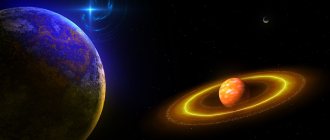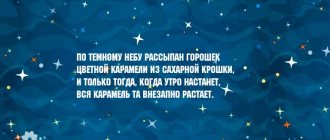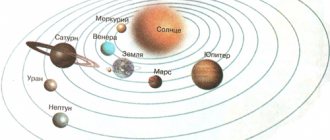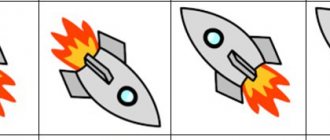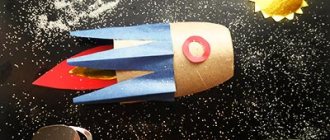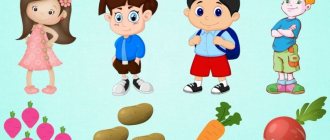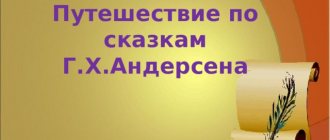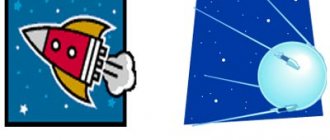Presentation “Journey into Space”
- May 22, 2012
Competition "Presentation Master - 2012"
Nomination "Presentation in the pedagogical process in preschool educational institutions"
To digest knowledge well, you need to absorb it with appetite.
A. France
The use of various methods of transmitting information in the classroom, including information and multimedia technologies, makes it possible to effectively carry out work on the cognitive development of preschool children and to take a creative approach to the process of solving the problems of teaching and upbringing.
The presentation “Journey into Space” was developed as part of a project for senior preschool age on the cognitive development of children “Me and the world around me,” of which I am the author. It was used in a travel lesson (educational area “Cognition, familiarization with the world around us”) (Appendix 2 Lesson notes) which made it possible to solve a number of problems:
- expanding children's knowledge about space, space objects, acquaintance with the history of space exploration, with the fact that the first cosmonaut in the world was a citizen of our country, Yuri Alekseevich Gagarin, who made his flight on April 12, 1967;
- development of memory, attention, imagination, fantasy, aesthetic perception;
- nurturing patriotic feelings, cognitive interest, and the desire to display one’s impressions in drawings.
This presentation made it possible to focus children’s attention on the space objects being studied and to interest them. The result of the lesson using this presentation was the cognitive and creative activity of the students. On the children's initiative, involving parents, we organized a role-playing game for children "Space Travelers" in the group, created a corner "Space", prepared a folder of consultations for parents, and held an exhibition of children's creative works on this topic.
This material can be used as a basis for classes, quizzes and other events on space topics (senior preschool and primary school age). By rearranging slides, adding and removing effects, video and audio fragments, the presentation is customized to the tasks of each specific teacher.
Application: Presentation.
Author: Polina Vladimirovna Sinenko, teacher of the 1st qualification category of MBDOU No. 81 Child Development Center - Kindergarten "Little Little Humpbacked Horse", Norilsk. In my teaching activities, I pay special attention to the cognitive development of children and broadening their horizons.
Presentation “Mysterious Space” - preschool education, presentations
Even more interesting presentations, educational games and activities at www.igraypodrastay.ru. To view the presentation in full screen mode, press
F5.
SPACE
Look at these babies - they look at the night sky with interest! There are so many beautiful stars there! Since ancient times, people have loved looking at the stars, and they were very interested in what they really were like!
And then one day they decided to fly into space! To the stars! To fly into space, people built a space rocket. An astronaut was put into the rocket - it was he who had to control the rocket and fly to the stars.
But the fact is that it is very, very cold in space. If you go into space without a special suit, you can instantly freeze and turn into ice. In addition, there is very little air in space and an ordinary person will not be able to breathe in it. That is why the astronaut who flew into space was wearing such a spacesuit. The suit is very warm and protects the astronaut from the cold even in space. In addition, a person can breathe in a spacesuit - it supplies the person with air.
The very first cosmonaut to fly into space was Yuri Gagarin.
When the astronaut got into the rocket, the countdown began: “Five, four, three, two, one, START!” The rocket took off from the ground, fire bursting from its tail - its engine was working so hard. And the rocket flew high into the sky.
She rose higher and higher! Look! She's already above the clouds!
And then the rocket ended up in outer space! This is what the astronauts saw in space!
This is our planet Earth - we live on it. As you can see, it is round – it looks like a big ball. Our planet is very, very large. That's why we don't notice that it looks like a ball. But if you rise high, high above the earth, then from space we will see it like in this picture.
Look, the blue spots on our planet are water - seas and oceans. Green spots are green forests and meadows. The brown spots are mountains. Isn’t it really very beautiful, our planet? And this small ball in the corner is our Moon!
The moon from space is also visible as a ball. The moon is much smaller than our planet Earth.
This is what the Moon looks like if you fly closer to it.
And this is how the astronauts saw our Sun. A huge glowing fireball. But the astronauts could not fly close to the Sun - because the Sun is very, very hot. If you get too close to it, you might even burn out.
Other stars that we see from Earth are also suns. They are just so far away from us that they seem like just small dots.
And the astronauts saw planets in space that revolved around the Sun.
Look, this picture shows all the planets that revolve around the Sun. Notice how huge our Sun is! It is larger than all the other planets combined! And our planet Earth - here it is - the third from the Sun - is very small compared to other planets.
In this picture you can see how different the size of the planets are and how big our Sun is. From Earth, the Sun does not seem so big to us because it is very far from us. In fact, that’s how huge it is!
All planets in the solar system revolve around the Sun in their orbit. On those planets that are very close to the Sun - it is very hot - hotter than in a hot frying pan! We couldn't have stayed there for even a second! And on the most distant planets - which are far from the Sun - on the contrary, it is very cold, because the sun's rays do not reach there well.
That's how many interesting things astronauts can see in space! Now you know about all this too!
You can find an interesting educational activity about space for three-year-old children, as well as other activities, games and presentations on the website www.igraypodrastay.ru
To view the presentation in full screen mode,
press F5
.
kopilkaurokov.ru
MAGAZINE Preschooler.RF
Presentation “What is Space” for older and preparatory children.The presentation contains 13 slides. Each slide contains a brief description of the planets, poems and riddles. Slide 1 – contains the title of the presentation “What is Space” . Slide 2 – a poem about space. Slide 3 - “Sun” - the only star in the solar system is the Sun. The sun is the source of life on Earth. The only star in the solar system is the sun. If you look at the sky, the Sun appears flat and small. But in fact, it is a huge fireball consisting of hot gases. The sun is very hot, and its surface is gases. The Sun is many times larger than the Earth - if you imagine the Earth in the form of a grain, then the Sun next to it will be the size of a watermelon. It is 109 times larger than Earth. Slide 4 - the concept of the solar system, 8 planets revolve around the sun: Mercury, Venus, Earth, Mars, Jupiter, Saturn, Uranus, Neptune. The planets and the Sun resemble a friendly family. The head of this family is the Sun! Among the planets there are large and small. Some of them are closer to the Sun, others are further from it. Each of the planets rotates in its own orbit. Neither planet ever collides with another or leaves the Solar System. The planet closest to the Sun is Mercury. It is smaller in size than the Earth and has a hard, rocky surface. Mercury has no atmosphere that could protect it from meteorite impacts and the scorching rays of the sun. It's very hot on this planet! Named after the Greek god Mercury. Slide 5 – description of the planet Venus. The second planet from the Sun is Venus. Venus glows on the heavenly dark blue velvet, like a crystal of rock crystal, and seems amazingly beautiful! That's why they named her in honor of the goddess of beauty - Venus.
The heat here is sizzling, so hot that you can bake a cake in a few seconds.
Venus is the brightest planet in the sky. The surface of Venus is rocky. This planet has an atmosphere, but it consists of carbon dioxide, which neither humans nor animals can breathe. Venus is surrounded by thick clouds. There is practically no water on it. Slide 6 – description of planet Earth. Our Earth is the third planet from the Sun.
It created favorable conditions for the life of plants, animals and people. Earth is a medium-sized planet. This is important, because if the planet is very small, then it will not have enough gravitational force to retain its atmosphere.
The atmosphere, which envelops the Earth in a bluish haze, has breathable air and protects the planet from overheating, cooling, and meteorite impacts.
In addition, a significant part of the surface of our planet is occupied by bodies of water. And water is necessary for all living organisms. Slide 7 – The Moon is a satellite of the Earth. The Earth has its own satellite - the Moon. Its surface is cold and dark. The moon does not glow itself; it, like a mirror, only reflects the sun's rays falling on it.
There are many depressions and deep holes on the rocky surface of the satellite, they are called craters. Craters appear when huge rock and ice meteorites fall onto the Moon from space. There is no water on the Moon, so the Moon is lifeless. The Moon revolves around the Earth, and together with the Earth, around the Sun. Slide 8 – description of the planet Mars. Mars is the fourth planet of the solar system. It is half the size of the Earth. Named after the god of war - Mars. Mars is the only planet similar to Earth in that it has four seasons, icy polar caps and channels resembling dry river beds. A year on Mars lasts twice as long as on Earth. This planet has an atmosphere, but it consists mainly of carbon dioxide. Mars is distinguished from other planets by its reddish glow, which is why it is often called the “Red Planet” . Slide 9 – description of the planet Jupiter. The fifth planet from the Sun is Jupiter. Jupiter is the largest planet in the solar system! It is so big that all the other planets could fit inside it. Jupiter is a giant ball consisting of liquid and gas. Jupiter gets a little heat from the Sun and therefore eternal winter reigns there. Jupiter has four moons that orbit around it. Named after the god of the sky, daylight, thunderstorms, father of all gods. Slide 10 – description of the planet Saturn. The sixth planet from the Sun is Saturn. Named after the god Saturn - the father of Jupiter. The planet is known for its magnificent rings. Each of Saturn's rings is made up of gases, ice particles, rocks and sand. Saturn is located far from the Sun and therefore its surface temperature is low. Slide 11 – description of the planet Uranus. The seventh planet from the Sun is Uranus. It is the only planet that rotates on its side. She is called a "lounger" . Therefore, first one side of it, then the other, is turned towards the Sun. Each hemisphere is illuminated by the Sun for exactly 40 years, and then night reigns there for 40 years. The atmosphere of Uranus is a cold fog.
Named after Saturn's father, Uranus. Slide 12 - description of the planet Neptune. The eighth planet from the Sun is Neptune. The planet is named after the Roman god of the sea, Neptune, because it is cold and blue. This is a huge ball consisting of gas and liquid. Neptune can only be seen through a telescope. The strongest winds in the solar system blow on the surface of the planet, reaching speeds of over 2000 km/h, which is 2 times faster than the speed of a jet airliner. Slide 13 – contains questions for consolidation.
| Next > |
